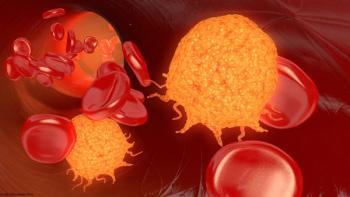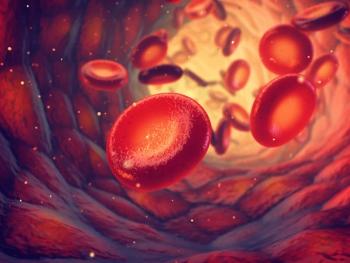
CHMP Recommends EU Approval for Glofitamab Combination in R/R DLBCL
Data from the phase 3 STARGLO study support the CHMP’s recommendation for approving glofitamab plus gemcitabine/oxaliplatin in relapsed/refractory DLBCL.
The Committee for Medicinal Products for Human Use (CHMP) of the European Medicines Agency (EMA) has recommended the approval of glofitamab-gxbm (Columvi) plus gemcitabine/oxaliplatin in the EU for patients with transplant-ineligible relapsed/refractory diffuse large B-cell lymphoma (DLBCL) not otherwise specified, and who are not eligible for an autologous stem cell transplant, according to a press release from the developer, Roche.1
The off-the-shelf glofitamab-based combination may become the first commercially available bispecific antibody regimen for this DLBCL population in the EU if approved. The European Commission is anticipated to issue a final decision on this indication in the near future.
“For patients with DLBCL who relapse after initial therapy, urgent and effective treatment is required to regain disease control. As the first bispecific antibody to show improved survival in DLBCL in a randomized phase 3 study, [glofitamab] could offer an additional treatment option that is immediately available for patients who relapse,” Levi Garraway, MD, PhD, chief medical officer and head of Global Product Development at Roche, stated in the press release.1
The CHMP based its recommendation on findings from the phase 3 STARGLO study (NCT03075696), in which investigators assessed the efficacy and safety of glofitamab plus gemcitabine/oxaliplatin vs rituximab (Rituxan) plus gemcitabine/oxaliplatin among those with previously treated relapsed/refractory DLBCL. Investigators previously published findings from the STARGLO study in The Lancet.2
According to an updated analysis with a median follow-up of 20.7 months (95% CI, 19.9-23.3), the median investigator-assessed overall survival (OS) was 25.5 months (95% CI, 18.3-not evaluable [NE]) in the glofitamab arm vs 12.9 months (95% CI, 7.9-18.5) in the rituximab arm (HR, 0.62; 95% CI, 0.43-0.88). Additionally, the median progression-free survival (PFS) per independent review committee (IRC) assessment was 13.8 months (95% CI, 8.7-20.5) and 3.6 months (95% CI, 2.5-7.1) in each respective arm (HR, 0.40; 95% CI, 0.28-0.57).
The IRC-assessed objective response rate (ORR) was 68.3% (95% CI, 61.0%-75.0%) with glofitamab-based treatment vs 40.7% (95% CI, 30.5%-51.5%) with the rituximab combination (P <.0001).
Data showed any adverse effect (AE) in 100% in the glofitamab arm vs 96% of the rituximab arm. The most common types of toxicity in each arm included thrombocytopenia (48% vs 48%), cytokine release syndrome (44% vs not available), neutropenia (42% vs 31%), anemia (41% vs 22%), and nausea (39% vs 40%).
In the international phase 3 STARGLO trial, 274 patients were randomly assigned to receive glofitamab (n = 183) or rituximab (n = 91) in combination with gemcitabine/oxaliplatin. Investigators administered rituximab at 375 mg/m2 intravenously on day 1 of each cycle for up to 8 cycles and glofitamab at step-up dosing for cycle 1 followed by 30 mg on day 1 of cycles 2 to 12. Additionally, all patients received gemcitabine intravenously at 1000 mg/m2 and oxaliplatin at 100 mg/m2 on day 2 of cycle 1 followed by day 1 of all subsequent cycles.
The trial’s primary end point was OS per investigator assessment. Secondary end points included PFS, complete response (CR) rate, duration of CR, ORR, and safety.
Patients 18 years and older with histologically confirmed DLBCL not otherwise specified who received 1 or more prior lines of systemic therapy were eligible for enrollment on the trial. Other requirements for study entry included having an ECOG performance status of 0 to 2 and relapsed/refractory disease. Those with DLBCL transformed from indolent lymphoma, double or triple hit lymphomas, or high-grade B-cell lymphoma were ineligible for enrollment.
The
References
- CHMP recommends EU approval of Roche’s Columvi combination for people with relapsed or refractory diffuse large B-cell lymphoma. News release. Roche. February 28, 2025. Accessed February 28, 2025. https://tinyurl.com/vr96hp97
- Abramson JS, Ku M, Hertzberg M, et al. Glofitamab plus gemcitabine and oxaliplatin (GemOx) versus rituximab-GemOx for relapsed or refractory diffuse large B-cell lymphoma (STARGLO): a global phase 3, randomised, open-label trial. Lancet. 2024;404(10466):1940-1954. doi:10.1016/S0140-6736(24)01774-4
- FDA accepts supplemental Biologics License Application for Roche’s Columvi combination for people with relapsed or refractory diffuse large B-cell lymphoma. News release. Roche. December 5, 2024. Accessed February 28, 2025. https://tinyurl.com/5edss86j
Newsletter
Stay up to date on recent advances in the multidisciplinary approach to cancer.


















































































